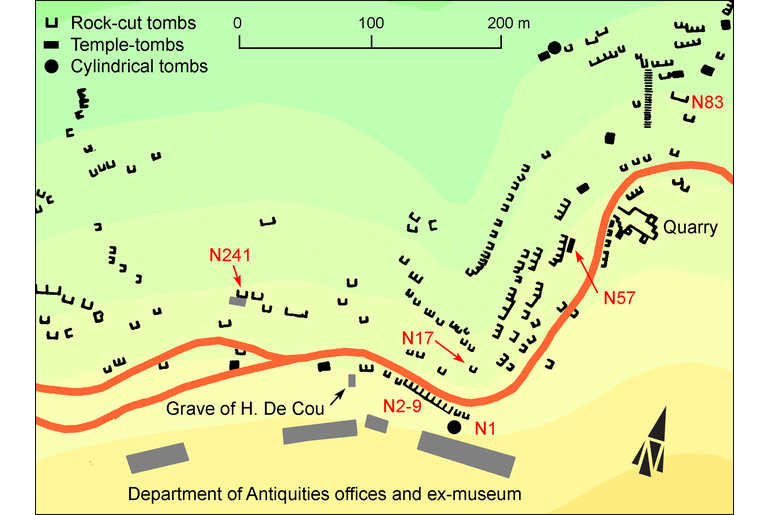Epitaph
IGCyr123000
Trismegistos ID: 738779
Source Description
Support
Rock-cut tomb with six loculi (dimensions unknown).
Layout
Inscribed in two lines over lintel of loculus 5.
Letters
Dimensions unknown; no description of the lettering.
Place of Origin
Findspot.
Date
Perhaps second century B.C. (context, lettering)
Findspot
Seen and copied by J. Cassels in 1954 at Cyrene pleiades; HGL : North Necropolis , tomb N384.
Last recorded Location
Seen by the Thorns in 2002 in situ (they describe two adjacent tombs and this is the left one).
Present Location
Not seen by IGCyr team.
Text constituted from
Transcription from previous mentions (CDL).
Bibliography
Thorn-Thorn, 2009 Thorn, D.M., Thorn, J.C. (eds.), 2009, A Gazetteer of the Cyrene Necropolis from the original notebooks of John Cassels, Richard Tomlinson and James and Dorothy Thorn, Studia Archaeologica161, Roma - see in bibliography , p. 126 (diplomatic copy from Cassels' notebook; no image).
Apparatus
2 Thorn-Thorn, 2009 Thorn, D.M., Thorn, J.C. (eds.), 2009, A Gazetteer of the Cyrene Necropolis from the original notebooks of John Cassels, Richard Tomlinson and James and Dorothy Thorn, Studia Archaeologica161, Roma - see in bibliography ΑΝΘΟ (Thorn's reading) : Thorn-Thorn, 2009 Thorn, D.M., Thorn, J.C. (eds.), 2009, A Gazetteer of the Cyrene Necropolis from the original notebooks of John Cassels, Richard Tomlinson and James and Dorothy Thorn, Studia Archaeologica161, Roma - see in bibliography [.] ΘΟ (Cassels' Grey Book)
French translation
(Tombe) de Kharôn et de [---] .
(ou)
(Tombe) de Kharôn fils de [---] .
English translation
(Tomb) of Charon and of [---] .
(or)
(Tomb) of Charon son of [---] .
Italian translation
(Tomba) di Charon e di [---] .
(o)
(Tomba) di Charon figlio di [---] .
Commentary
With two names above the same loculus and the first one at the genitive case, it is impossible to decide whether the second name is a father's name or the name of a second person also placed into the same loculus.
Confronting the diplomatic transcriptions of Cassels and the Thorns, we may imagine several restorations for the second line: either, with one letter missing at the beginning, the name Ξάνθος, a well-known Greek name not hitherto attested in Cyrenaica, or a name in Ἀνθο-, for which there are few possibilities: compounds with that first element are very rare everywhere, but theoretically not impossible in Cyrenaica, where the reverse compounds in -άνθης are favourites. However, it is also possible that we have here the feminine name Ἀνθοῦσα. So the question should remain open.
The date of the inscription was suggested by the Thorns.
Creative Commons Attributions-NonCommercial 4.0 International License.
All citation, reuse or distribution of this work must contain a link back to DOI: http://doi.org/10.6092/UNIBO/IGCYRGVCYR and the filename (IGCyr000000 or GVCyr000), as well as the year of consultation.
